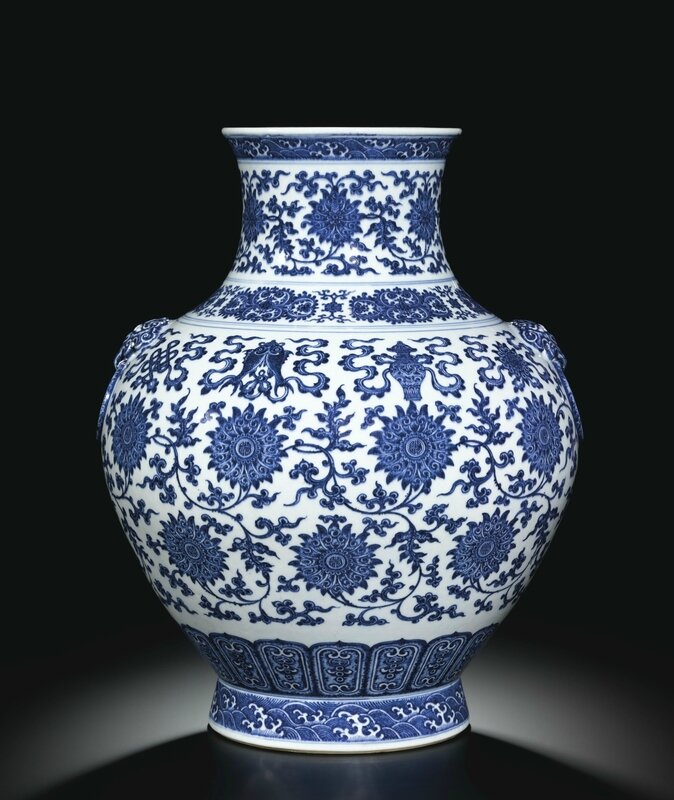A fine large blue and white Ming-style vase, hu, Seal mark and period of Qianlong (1736-1795)
Lot 3037. A fine large blue and white Ming-style vase, hu. Seal mark and period of Qianlong (1736-1795); 49 cm., 19 1/4 in. Estimate 10,000,000 - 12,000,000 HKD. Lot sold 10,840,000 HKD. Photo: Sotheby's 2013.
the robust ovoid body supported on a splayed foot, sweeping up to a waisted neck and everted rim, set with two taotie-mask handles suspending mock rings, brightly painted in deep shades of cobalt accented by contrived 'heaping and piling' with a wide band of scrolling lotus, the large blooms borne in an alternating double register with the upper row each supporting one of the beribboned bajixiang, the neck encircled by a band of quatrefoil crenulated motifs divided by flower sprigs and further wrapped with a lotus scroll, the base skirted with petal panels, all between a band of tumultuous waves encircling the rim and foot, the base inscribed in underglaze blue with a six-character seal mark.
Provenance: Sotheby's London, 14th May 2008, lot 683.
Note: Impressive for its large size, flawless potting and finely executed decoration, this vase represents one of the finest porcelain designs influenced by Ming ceramic patterns but adapted to suit the contemporary Qianlong period taste. The decoration is also notable for the brilliance of the blue cobalt, which reflects the high level of resources available and the technical excellence of the potters working in the imperial kilns at Jingdezhen under the guidance of China’s most famous Superintendent, Tang Ying. The Qianlong Emperor is known to have commissioned artists producing wares for the court to make pieces that were challenging and striking, often placing more emphasis on showier aspects of production and on the virtuosity of craftsmanship. Under his tutelage the refinement of the material and advances in craftsmanship allowed potters to become more ambitious in their repertoire. The making of large vessels, together with the composition of a complex design, required much thought and skill to create a harmonious overall product such as the present piece.
This hu demanded considerable expertise and the potter has borrowed extensively from archaic styles and forms while creating a piece that is both steeped in tradition yet innovative. The reference to the archaic bronze hu vessel is a direct response to the Qianlong Emperor, who was a great connoisseur and collector of archaic bronzes, jades and works of art. He was also an ardent follower of Tibetan Buddhism, thus references to symbols such as the bajixiang would have ranked among his favourite motifs. Each symbol, the Wheel of Law, the Conch, the Standard of Victory, the Parasol, the Lotus, the Vase, the Twin Fish and the Endless Knot, has been carefully rendered above a lotus bloom containing shou characters in the centre to result in a highly auspicious and visually appealing vessel.
A closely related vase is illustrated in Chinese Porcelain. The S.C. Ko Tianminlou Collection, Hong Kong, 1987, pl. 58, where the design is described by Julian Thompson as the ‘culmination of the long progression of transformation of the early 15th century style’, with all the bands of decoration being adapted from 15th century designs excluding the quatrefoils on the shoulder. Another vase of this type, in the Aurora Art Museum, Taipei, is illustrated in Appreciation of Blue and White Porcelains, Taipei, 2008, pl. 52; one believed to have come from the Royal Collections at Windsor Castle and to have been presented by Queen Mary to Sir Ralph Harwood, K.C.B., K.C.V.O. at one time Financial Secretary to King George V and Controller of the Royal Household, was sold in our London rooms, 7th June 1994, lot 358; and a third vase was included in the Min Chiu Society exhibition Anthology of Chinese Art, Hong Kong, 1985, cat. no. 185.
Much smaller vases of this form decorated with a different design pattern are known; see a Qianlong vase painted with a band of leafy lotus blooms above a composite flower scroll band and a larger band of crashing waves, in the National Palace Museum, Taipei, published in Blue and White Ware of the Ch’ing Dynasty, Hong Kong, 1968, pl. 2.
Vases of this hu form remained popular and continued to be made throughout the Qing period; see a Daoguang version included in Geng Baochang, Ming Qing ciqi Jianding [Appraisal of Ming and Qing porcelains], Hong Kong, 1993, pl. 510.

/https%3A%2F%2Fprofilepics.canalblog.com%2Fprofilepics%2F1%2F0%2F100183.jpg)
/https%3A%2F%2Fstorage.canalblog.com%2F03%2F02%2F119589%2F96711876_o.jpg)
/https%3A%2F%2Fstorage.canalblog.com%2F11%2F31%2F119589%2F94773502_o.jpg)
/https%3A%2F%2Fstorage.canalblog.com%2F20%2F83%2F119589%2F94772815_o.jpg)
/https%3A%2F%2Fstorage.canalblog.com%2F26%2F72%2F119589%2F75604929_o.jpg)
/https%3A%2F%2Fstorage.canalblog.com%2F59%2F60%2F119589%2F26458628_o.jpg)





/image%2F1371349%2F20240416%2Fob_2a8420_437713933-1652609748842371-16764302136.jpg)
/image%2F1371349%2F20240414%2Fob_83ee65_2024-nyr-22642-0954-000-a-blue-and-whi.jpg)
/image%2F1371349%2F20240414%2Fob_15808c_2024-nyr-22642-0953-000-a-blue-and-whi.jpg)
/image%2F1371349%2F20240414%2Fob_e54295_2024-nyr-22642-0952-000-a-rare-blue-an.jpg)